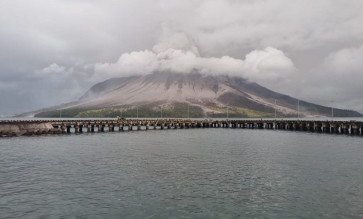Optimism over new fashion road map
As the local fashion industry gains prominence, the government has prepared a blueprint to ensure that it doesn’t lose its spark
Change Size

A
s the local fashion industry gains prominence, the government has prepared a blueprint to ensure that it doesn’t lose its spark.
The roadmap is the work of the Indonesian Fashion Designers Association (APPMI) in collaboration with the Tourism and Creative Economy Ministry, Trade Ministry, Industry Ministry and the Cooperatives and Small and Medium Enterprises Ministry.
“The blueprint comprises a strategy that will see Indonesia become an inspiration through trend prospects and mapping work from the four ministries,” Indonesia Fashion Week (IFW) director Dina Midiani said ahead of the fashion event in Jakarta.
The strategy is to encourage innovation, creating a brand enriched by local culture and an eco-friendly spirit based on research and development, competency and a business approach to produce ready-to-wear fashion — all with the aim of brushing shoulders with the world’s fashion centers of Milan, Paris and New York by 2025.
“Amid those efforts, we really hope that our fashion industry can focus on ready-to-wear products for the middle-class,” added Dina.
Sounds too ambitious? Not so, say most fashion designers, as long as the government gives its full commitment to creating a better production and business environment for them.
Based on the blueprint, the Tourism and Creative Economy Ministry will play a part in developing designs and trends, including forecasting fashion trends.
The Industry Ministry will develop all aspects relating to production, including small to middle businesses, production technology, material development, standardization and the protection of intellectual rights.
The Trade Ministry has been tasked with marketing and promotion, which involves logistics and distribution as well as setting up exhibitions both in Indonesia and overseas.
Meanwhile, the Cooperatives and Small and Medium Enterprises Ministry will handle specific development in micro to small-middle enterprises as well as give support at the cooperation level.
In the blueprint, all ministries have the duty to build the skills of all people in the industry.
Tourism and Creative Economy Minister Mari Elka Pangestu said that over the past couple of years, Indonesia had shown significant developments in its creative economy businesses, including in fashion.
The country’s fashion industry contributed Rp 164 trillion (US$17 billion) to the national gross domestic product (GDP) in 2012, a significant surge from just Rp 28 trillion in 2010, while overall, the creative economy sector contributed Rp 570 trillion in 2012 from Rp 437 trillion in 2010, said Mari.
“[The creative economy] created 11.8 million jobs in 2012, in which fashion-related jobs made up 3.8 million. The creative economy, especially fashion, has a lot of potential as there is a huge market in the country and an increasing middle-class that is willing to pay more for particular brands and designs,” Mari said.
“The government sees this as great potential. Therefore, over the past two years, the four ministries along with all stakeholders in Indonesian fashion have worked together to produce this comprehensive program, which will support the whole industry to reach the 2025 target.”
To achieve that target, Indonesia must first become the leader in the Muslim market by 2015, in the Asian market by 2018 and in the world Muslim market by 2020.
Muslim clothing is at the forefront of the local fashion movement due to its local popularity, given that Indonesia is a Muslim-majority country. There are also emerging markets in some neighboring countries like Malaysia, Singapore and Brunei.
“Our closest markets in Asia are Southeast Asian countries like Malaysia, Singapore, Thailand and even the Philippines. Muslim wear has a powerful market in the country, has developed really well in terms of innovation and I believe it has become a trendsetter.
“We need to support [the Muslim wear market] as it will be something we can rely on in the Asian market as well as in the Middle East in the future. I’m sure we can work on these two [Asia and Middle East],” said Mari.
APPMI chief Taruna K. Kusmayadi said one among many problems faced by most local designers was limited access to material.
“We don’t have a license to directly import and our needs are too small for local companies. As result, we have to purchase the material in retail, meaning that we see an increase of 400 percent in price from the original cost of production. We really hope local garment companies will cooperate with us on that,” he said.
Indonesian Employers Association (APINDO) chairman Sofjan Wanandi promised to help local fashion entrepreneurs, saying the association would help with the coordination of many parties in relation to standardization, branding and promotion.
“We will support Indonesian fashion because I believe we deserve to be the best in the world,” he said.
Rising fashion designer Lenny Agustin said it was about time for Indonesia to eventually have a clear plan for its fashion industry.
“Most countries with good fashion industries like Hong Kong and South Korea have this kind of blueprint. In Hong Kong, for example, when I was working in fashion there, I got support from a textile company,” she said.
Lenny said a textile company would benefit more as the fashion brand it endorsed would reach a wider market.
Noted fashion artisan Musa Widyatmodjo also placed his faith in the road map. “It’s not lip service because stakeholders in fashion were involved in the making of it.”









